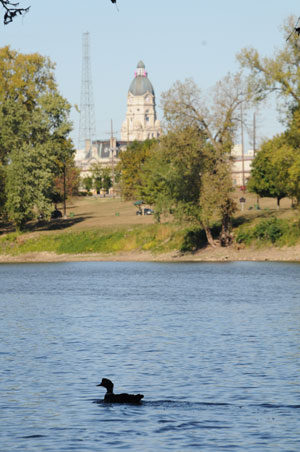Wabash River Heritage Corridor Fund (WRHCF)
 History
History
In the late 1980's, the Indiana General Assembly began receiving new requests for assistance with conservation and recreational development along the Wabash River and its historic transportation corridor. A Wabash River Heritage Corridor Fund (WRHCF) bill was passed to do just that. As this surge of enthusiasm and interest began to grow, monies were appropriated by the General Assembly to assist in the renaissance of the Wabash River. From 1990 to 2000, almost $8 million has been allocated to the river corridor. With the Department of Natural Resources administrating these funds, along with the creation of the Wabash River Heritage Corridor Commission (WRHCC) to promote the corridor, the opportunity for natural/recreational as well as historical/cultural projects along the Wabash River corridor has materialized. Nineteen counties in the corridor along the Wabash River, Little River and the historic portage to the Maumee River are eligible to utilize the WRHCF. 2000 was the last year of funding from the General Assembly.
In 2009, legislation was revised to allow a new source of dedicated money to be placed in the fund. This fund will be used to once again fund projects in the Wabash River Corridor.
Where are the funds from?
The owners of land in Indiana are due royalties from oil and other minerals collected beneath their property. Because no person or agency owns the Wabash River, the royalties collected have gone into the state general fund. In 2009, IC 14-13-6 was revised to put this money in a non-reverting fund for grants in the Wabash River corridor. The revenue is approximately $100,000 per year.
What are the priorities for the grant?
Grant rounds have traditionally either had an outdoor recreation focus or a historical and cultural focus, each with different priorities. The 2024 grant round will fund historical and cultural projects.
Historical and Cultural projects:
- Rehabilitation, preservation, or stabilization of deteriorated, threatened, and/or endangered historical/cultural sites and structures that are listed in the State Register (or have been formally determined by the Division of Historic Preservation & Archaeology as eligible for listing in the State Register prior to the grant application deadline). All proposed projects must be designed to be carried out in accordance with the applicable Secretary of the Interior’s Standards for the Treatment of Historic Properties.
- Archaeological survey, site evaluation, or data recovery projects. All proposed projects must be designed to be carried out in accordance with the applicable DHPA guidelines and requirements for archaeological work.
- Acquisition of land containing sensitive and/or threatened archaeological sites that are listed in the State Register (or have been formally determined by the DHPA as eligible for listing in the State Register prior to the grant application deadline) for purposes of permanent site control and protection.
- Design and fabrication of educational/interpretive exhibits related to specific cultural resources that are physically and contextually related to the development of the corridor.
Outdoor Recreation projects:
- Camping - Sites and facilities that allow river users to camp overnight for an extended Wabash River experience are the top priority.
- Access - The next priority is creating public access to the river. Sites that fill gaps in access are preferred.
- Trails - There is always a need for bicycle/pedestrian trails along the Wabash River.
How do I apply for the funds?
Visit the WRHCF grants webpage for more info and application details.
